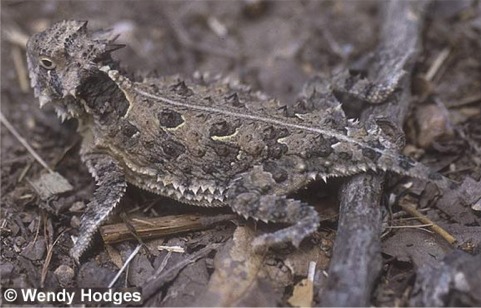
| One of the most important means of adaptations that the Texas Horned
Lizard has is the mechanism of defense is the ability to change colors
so that it can blend in with its surroundings. In order to avoid
predators, the specimens near the eastern boundary, where the trees are
more abundant, tend to be darker with distinct face bars and gray,
heavily spotted bellies. If they live in the grassy plains they tend to
be lighter in color. The specimens that live in the Rio Grande Valley
and to the south appear to be a brighter grey and tend to have narrow
face bars and white bellies. Another unique defense is its "horny-like" body hence the name horned lizard.
|
| Camouflage, Sprinting, Fight or Blood squirting |
| The Texas Horned Lizard has a great deal of trickery when it comes to getting away from a predator, but they usually have three basic means of defense: they can hide, flee, or attack. Camouflage is their first choice of defense, they simply mimic their background so they blend in with their surrounding so they go undetected, but if they are discovered they sometimes play dead until the predator loses interest. If the predator finds them and insists on having them for lunch, then they usually use the sprinting method to escape. If these methods fail then the attack method is used. The Texas Horned Lizard starts its attack by puffing itself up to make it look bigger than it actually is, so to a snake it would appear too big, plump, and spiny to eat. It also makes itself look fierce like a small dragon by hissing and lunging towards the threatening predator, it also can vibrate its tail very vigorously if its on dry leaves making more noise to make it seem more fierce than it really is. This method can be very effective (Manaster). Another unique form of defense is when blood is squirted from the orbital sinuses of the eyes. There were tests conducted using a dog as the staged predatory-prey, and when they dog would bark and scare the lizard 47 out of 55 (87%) of the lizards squirted blood (Sherbrooke Candid Elicitation). Blood can be discharged up to 4 feet either forward or backwards, by one eye or two. It is a quick process and the squirting only lasts a moment, yet the process can be repeated 2-3 times. After it has squirted it can be ready to do the process all over again just a few minutes later. Even though the blood is almost tasteless most of its predators like foxes and coyotes find it very unpleasant, so therefore it adds to the already long list of good defense tactics (Sherbrooke Behavior and Integumental Morphology). |












